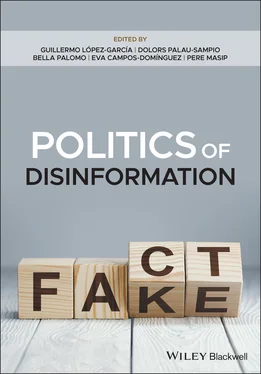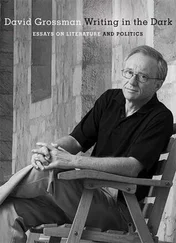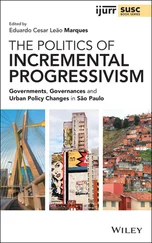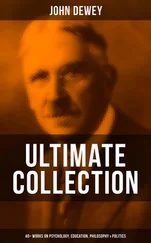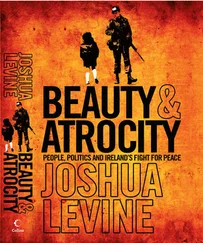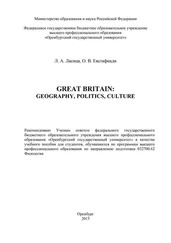Politics of Disinformation
Здесь есть возможность читать онлайн «Politics of Disinformation» — ознакомительный отрывок электронной книги совершенно бесплатно, а после прочтения отрывка купить полную версию. В некоторых случаях можно слушать аудио, скачать через торрент в формате fb2 и присутствует краткое содержание. Жанр: unrecognised, на английском языке. Описание произведения, (предисловие) а так же отзывы посетителей доступны на портале библиотеки ЛибКат.
- Название:Politics of Disinformation
- Автор:
- Жанр:
- Год:неизвестен
- ISBN:нет данных
- Рейтинг книги:5 / 5. Голосов: 1
-
Избранное:Добавить в избранное
- Отзывы:
-
Ваша оценка:
- 100
- 1
- 2
- 3
- 4
- 5
Politics of Disinformation: краткое содержание, описание и аннотация
Предлагаем к чтению аннотацию, описание, краткое содержание или предисловие (зависит от того, что написал сам автор книги «Politics of Disinformation»). Если вы не нашли необходимую информацию о книге — напишите в комментариях, мы постараемся отыскать её.
Discover a comprehensive exploration of the underlying theories of disinformation, and their impact, from leading voices in the field Politics of Disinformation
Politics of Disinformation
Politics of Disinformation — читать онлайн ознакомительный отрывок
Ниже представлен текст книги, разбитый по страницам. Система сохранения места последней прочитанной страницы, позволяет с удобством читать онлайн бесплатно книгу «Politics of Disinformation», без необходимости каждый раз заново искать на чём Вы остановились. Поставьте закладку, и сможете в любой момент перейти на страницу, на которой закончили чтение.
Интервал:
Закладка:
A longitudinal study of the use of these concepts in the academic literature evinces the growing interest in this area of investigation, especially from 2016 onwards, when “post-truth” was chosen as word of the year (Wang 2016) due to the notoriety it had achieved during the Brexit referendum and the US presidential election (Jankowski 2018), which resulted in the appearance of numerous publications from 2017 onwards ( Table 1.1). Although mentions in the academic record dating back four decades have been localized, these studies were carried out sporadically. Proof of this is that up until 2012 one or two articles at the most appeared each year, which contrasts with the 179 new publications registered in 2019 alone, accounting for one third of the sample. The COVID-19 crisis has significantly influenced the level of production, continuously accelerating the various phases involved in publication, which is why it is foreseeable that at the end of 2020 the number of articles and publications registered will be higher than that achieved the previous year.
Table 1.1 Annual production indexed in WoS
| Year | Matches | % | Year | Matches | % | Year | Matches | % | ||
|---|---|---|---|---|---|---|---|---|---|---|
| 2020 a | 151 | 28.2 | 2011 | 4 | 0.6 | 2002 | 2 | 0.4 | ||
| 2019 | 179 | 33.4 | 2010 | 4 | 0.7 | 2000 | 2 | 0.4 | ||
| 2018 | 97 | 18.1 | 2009 | 1 | 0.2 | 1999 | 1 | 0.2 | ||
| 2017 | 30 | 5.6 | 2008 | 2 | 0.4 | 1998 | 1 | 0.2 | ||
| 2016 | 13 | 2.4 | 2007 | 1 | 0.2 | 1997 | 1 | 0.2 | ||
| 2015 | 16 | 3.0 | 2006 | 2 | 0.4 | 1996 | 1 | 0.2 | ||
| 2014 | 9 | 1.7 | 2005 | 3 | 0.6 | 1992 | 1 | 0.2 | ||
| 2013 | 9 | 1.7 | 2005 | 3 | 0.6 | 1992 | 1 | 0.2 | ||
| 2013 | 9 | 1.7 | 2005 | 3 | 0.6 | 1992 | 1 | 0.2 | ||
| 2012 | 3 | 0.6 | 2003 | 1 | 0.2 | 1980 | 1 | 0.2 | ||
| aFrom January to August 2020. |
With respect to searching by concepts to determine their longevity, analysis of the texts indexed in WoS confirms that in 1980 the first article appeared that included the word “fact-check” in its title. It was published in the professional journal Columbia Journalism Review (Ridder 1980) and described and compared the work developed by fact-checkers in US newsrooms. In 1983 a newspaper chronicle by Robert Kaplan tackled disinformation in Greece in pioneering fashion in that same journal, and in the 1990s several authors analyzed the news coverage of AIDS, some of which was considered “deliberate misinformation” (Price and Hsu 1992; Bird 1996). However, “fake news,” currently the most widespread term of those analyzed, was not used until 2005 (Baym 2005). The texts that appear in this paragraph and other similar ones have been excluded from the qualitative analysis of this chapter as they lack an explicit methodology, but they must be mentioned because they show the existence of a historical debate within the journalistic profession on the veracity of content, although that concern has intensified and been addressed with greater scientific rigor more recently. The current stage has also favored the emergence of new concepts, such as “junk news,” which refers to sources that deliberately publish misleading, deceptive, or incorrect information packaged as real news (Bradshaw et al. 2020), or “news-ness,” the extent to which audiences characterize specific content as news (Edgerly and Vraga 2020).
In this context there is a predominance of articles with multiple authorship (70%), a decision that is probably justified by the complexity of the phenomenon and a multidisciplinary approach. This analysis makes it possible to compile the list of the most productive and reputed authors in this line of research, led by three women, Emily Vraga (13 articles), Leticia Bode (8), and Michelle Amazeen (7), followed by Lucas Graves, Michael Hameleers, Edson C. Tandoc Jr. (6), H. Lee, Richard Ling, and Chris Wells (5). In terms of affiliation, 14 universities account for a quarter of the entire production analyzed, with North American institutions occupying a dominant position. Outstanding in this respect is the University of Wisconsin, where the greatest number of articles registered in WoS (22) are generated, followed by the universities of Boston (15), Pennsylvania Commonwealth System of Higher Education, London (12), George Mason, Minnesota, Austin Texas (11), Georgetown, Harvard, Northwestern, Ohio State, Amsterdam, Oxford, and, in Singapore, Nanyang Technological University (10).
This domination of the research influences the language that predominates in the articles. Ninety-one percent of production is in English (487 articles), while Spanish comes a long way behind with 41 articles (7.6%). With insignificant percentages there are three articles in German, another three in Russian, one in Slovene, and another in Catalan.
In keeping with the geographical distribution of universities, the countries that show the greatest number of academic publications related to the issue ( Table 1.2) are led by the United States (45.5% of the articles analyzed), followed by the United Kingdom (11.8%) and Spain (11%). Nonetheless, the proof that disinformation is a global and widespread concern lies in the fact that the investigations originate from some fifty countries, amongst which the European continent takes on an important role as 45.8% of those countries are located there.
Table 1.2 The 10 countries that produce thegreatest volume of articles related to disinformation
| Country | Matches | % |
|---|---|---|
| USA | 249 | 46.5 |
| United Kingdom | 63 | 11.8 |
| Spain | 59 | 11.0 |
| Australia | 27 | 5.0 |
| Germany | 27 | 5.0 |
| Netherlands | 21 | 3.9 |
| Canada | 16 | 2.9 |
| Singapore | 13 | 2.4 |
| Denmark | 12 | 2.2 |
| Switzerland | 12 | 2.2 |
The total number of journals from the Communication field that have published research related to disinformation is 64. Journals housing more than 5% of the total publications were considered to be the most committed to this issue; making calls for special issues has an influence on this. The most active are El Profesional de la Información and Social Media + Society , which surpass thirty registers each, New Media & Society and the International Journal of Communication (26), and Digital Journalism (24). Journalism Practice (23), Information, Communication & Society , and Political Communication (20) come close to these figures.
The exponential growth experienced in recent years by studies on disinformation has also had a positive influence on their impact. As a general figure, the average number of citations in other high impact publications obtained per article in Web of Science is 8.6. Table 1.3shows the five most-cited articles, characterized by their addressing contexts and employing diverse methodologies, although politics is the central pivot in three of the investigations. The most referenced amongst them is “The Daily Show: Discursive integration and the reinvention of political journalism” (Baym 2005), a classic case study of the discipline that pioneered the use of “fake news.” Close behind is a recently published conceptual investigation, the work of Tandoc et al. (2018) titled “Defining fake news: A typology of scholarly definitions,” which in only two years has achieved 219 citations, thanks to the taxonomy proposed. The third article is an essay that analyzes Donald Trump’s Twitter feed and concludes that his success is due to simple, impulsive, and uncivil discourses (Ott 2017). The fourth place is occupied by Engesser et al. (2017), who develop a qualitative study on the rise of populism on Facebook and Twitter comparing four scenarios: Austria, Italy, Switzerland, and United Kingdom. Also on this list is an article that, by employing experimental techniques based on exposing users to misinformation content, evaluates the cognitive processes involved in processing verification and analyzes the incidence of corrections in the perception of news (Bode and Vraga 2015).
Читать дальшеИнтервал:
Закладка:
Похожие книги на «Politics of Disinformation»
Представляем Вашему вниманию похожие книги на «Politics of Disinformation» списком для выбора. Мы отобрали схожую по названию и смыслу литературу в надежде предоставить читателям больше вариантов отыскать новые, интересные, ещё непрочитанные произведения.
Обсуждение, отзывы о книге «Politics of Disinformation» и просто собственные мнения читателей. Оставьте ваши комментарии, напишите, что Вы думаете о произведении, его смысле или главных героях. Укажите что конкретно понравилось, а что нет, и почему Вы так считаете.
